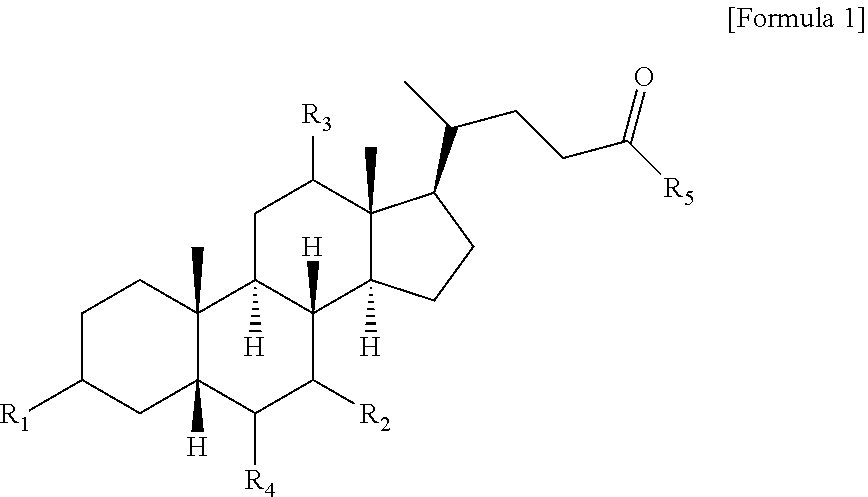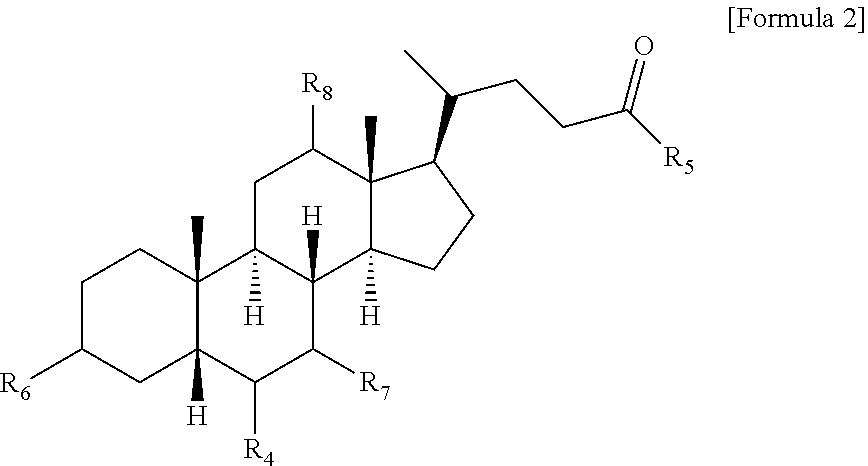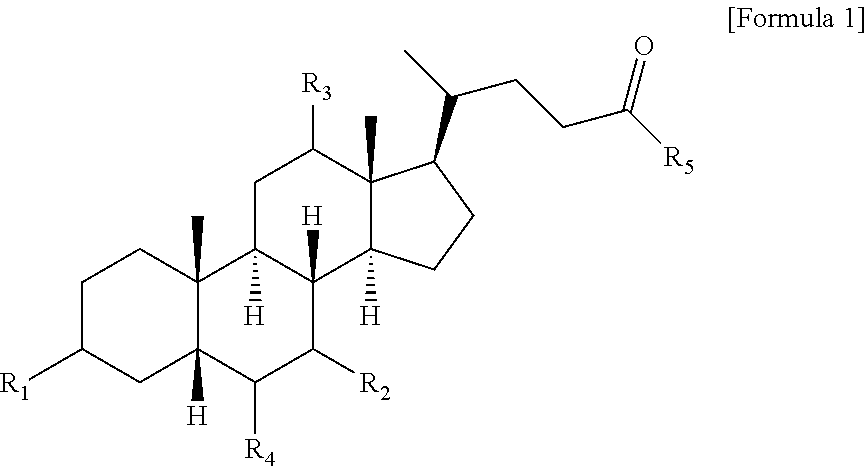Method for preparing bile acid derivative by using continuous flow reaction
- Summary
- Abstract
- Description
- Claims
- Application Information
AI Technical Summary
Benefits of technology
Problems solved by technology
Method used
Image
Examples
example 1
[0070]A cartridge column for a continuous flow reaction was filled with 0.67 g of a palladium hydroxide catalyst and washed with isopropyl alcohol to remove water contained in the catalyst. 1.0 g of 7-keto-lithocholic acid (KLCA) as a starting material and 144 mg of KOH were well dissolved in 50 mL of isopropyl alcohol, and then 144 mg of tert-BuOK was added thereto and the resulting solution was stirred at room temperature for 10 minutes.
[0071]The temperature of the cartridge column was raised to 40° C., hydrogen was supplied thereinto at a flow rate of 5 mL / min, and the reaction solution was allowed to flow thereinto at a flow rate of 100 μL / min, to perform a hydrogenation reaction. The temperature of the catalyst column was raised to 80° C. at a hydrogen flow rate of 5 ml / min, and the flow rate of the reaction solution was fixed at 60 μL / min to perform the hydrogenation reaction.
[0072]At the time of reaction completion, ursodeoxycholic acid (UDCA) was produced with a yield of 95%...
example 2
[0073]A cartridge column for a continuous flow reaction was filled with 0.67 g of a Raney Ni catalyst and water was removed therefrom using isopropyl alcohol. 1.0 g of KLCA as a starting material and 144 mg of KOH were well dissolved in 50 mL of isopropyl alcohol, and then the 144 mg of t-BuOK was added thereto and the resulting solution was stirred at room temperature for 10 minutes.
[0074]The temperature of the cartridge column was raised to 40° C., hydrogen was supplied thereinto at a flow rate of 5 mL / min, and the reaction solution was allowed to flow thereinto at a flow rate of 60 μL / min, to perform a hydrogenation reaction. The temperature of the catalyst column was raised to 80°C. at a hydrogen flow rate of 5 mL / min, and the flow rate of the reaction solution was fixed at 60 μL / min to perform the hydrogenation reaction
[0075]At the time of reaction completion, UDCA was produced with a yield of 95% within several minutes, and the obtained conversion rate (UDCA:CDCA) of the UDCA ...
example 3
[0076]In a general reactor, 1.0 g of KLCA as a starting material and 144 mg of KOH were well dissolved in 50 mL of isopropyl alcohol, and then 144 mg of t-BuOK was added thereto and the resulting solution was stirred at room temperature for 10 minutes. 0.67 g of a palladium hydroxide catalyst was washed with 10 ml of isopropyl alcohol in a nitrogen atmosphere and filtered, and this process was repeated three times. Lastly, the palladium hydroxide catalyst, which became wet due to the isopropyl alcohol, was added to the reaction solution and uniformly mixed. The temperature of the continuous flow reactor was raised to 40° C. The reaction solution was allowed to flow into the first line of the continuous flow reactor at a flow rate of 100 μL / min, and hydrogen was supplied into the second line thereof at a flow rate of 5 mL / min and a pressure of 5 bar to perform a hydrogenation reaction. After the reaction was completed, the catalyst was filtered. At the time of reaction completion, UD...
PUM
 Login to View More
Login to View More Abstract
Description
Claims
Application Information
 Login to View More
Login to View More - R&D
- Intellectual Property
- Life Sciences
- Materials
- Tech Scout
- Unparalleled Data Quality
- Higher Quality Content
- 60% Fewer Hallucinations
Browse by: Latest US Patents, China's latest patents, Technical Efficacy Thesaurus, Application Domain, Technology Topic, Popular Technical Reports.
© 2025 PatSnap. All rights reserved.Legal|Privacy policy|Modern Slavery Act Transparency Statement|Sitemap|About US| Contact US: help@patsnap.com



